www.ti.com
SN65HVD230
SN65HVD231
SN65HVD232
SLOS346K –MARCH 2001–REVISED FEBRUARY 2011
3.3-V CAN TRANSCEIVERS
Check for Samples: SN65HVD230, SN65HVD231, SN65HVD232
Industrial Automation
APPLICATIONS
• Motor Control
•
• Basestation Control and Status
• Robotics
• Automotive
• UPS Control
1FEATURES
2• Operates With a 3.3-V Supply
• Low Power Replacement for the PCA82C250
Footprint
• Bus/Pin ESD Protection Exceeds 16 kV HBM
• High Input Impedance Allows for 120 Nodes on
a Bus
• Controlled Driver Output Transition Times for
Improved Signal Quality on the SN65HVD230
and SN65HVD231
• Unpowered Node Does Not Disturb the Bus
• Compatible With the Requirements of the ISO
11898 Standard
• Low-Current SN65HVD230 Standby Mode
370 μA Typical
• Low-Current SN65HVD231 Sleep Mode 40 nA
Typical
• Designed for Signaling Rates(1) up to 1
Megabit/Second (Mbps)
• Thermal Shutdown Protection
• Open-Circuit Fail-Safe Design
• Glitch-Free Power-Up and Power-Down
(1)
Protection for Hot-Plugging Applications
The signaling rate of a line is the number of voltage
transitions that are made per second expressed in the units
bps (bits per second).
LOGIC DIAGRAM (POSITIVE LOGIC)
1
Please be aware that an important notice concerning availability, standard warranty, and use in critical applications of Texas
Instruments semiconductor products and disclaimers thereto appears at the end of this data sheet.
2TMS320Lx240x is a trademark of Texas Instruments.
PRODUCTION DATA information is current as of publication date.
Products conform to specifications per the terms of
the Texas
Instruments standard warranty. Production processing does not
necessarily include testing of all parameters.
© 2001–2011, Texas Instruments Incorporated
DGNDVCCRRSCANHCANLVrefSN65HVD230D (Marked as VP230)SN65HVD231D (Marked as VP231)(TOP VIEW)12348765NC – No internal connectionDGNDVCCRNCCANHCANLNCSN65HVD232D (Marked as VP232)(TOP VIEW)12348765CANLCANHRD1476SN65HVD230, SN65HVD231Logic Diagram (Positive Logic)RS8Vref53VCCCANLCANHRD1476SN65HVD232Logic Diagram (Positive Logic)�
SN65HVD230
SN65HVD231
SN65HVD232
SLOS346K –MARCH 2001–REVISED FEBRUARY 2011
www.ti.com
These devices have limited built-in ESD protection. The leads should be shorted together or the device placed in conductive foam
during storage or handling to prevent electrostatic damage to the MOS gates.
these devices feature cross-wire protection,
DESCRIPTION
The SN65HVD230, SN65HVD231, and SN65HVD232 controller area network (CAN) transceivers are designed
for use with the Texas Instruments TMS320Lx240x™
; 3.3-V DSPs with CAN controllers, or with
equivalent devices. They are intended for use in applications employing the CAN serial communication physical
layer in accordance with the ISO 11898 standard. Each CAN transceiver is designed to provide differential
transmit capability to the bus and differential receive capability to a CAN controller at speeds up to 1 Mbps.
Designed for operation in especially-harsh environments,
loss-of-ground and overvoltage protection, overtemperature protection, as well as wide common-mode range.
The transceiver interfaces the single-ended CAN controller with the differential CAN bus found in industrial,
building automation, and automotive applications. It operates over a -2-V to 7-V common-mode range on the
bus, and it can withstand common-mode transients of ±25 V.
On the SN65HVD230 and SN65HVD231, pin 8 provides three different modes of operation: high-speed, slope
control, and low-power modes. The high-speed mode of operation is selected by connecting pin 8 to ground,
allowing the transmitter output transistors to switch on and off as fast as possible with no limitation on the rise
and fall slopes. The rise and fall slopes can be adjusted by connecting a resistor to ground at pin 8, since the
slope is proportional to the pin's output current. This slope control is implemented with external resistor values of
10 kΩ, to achieve a 15-V/μs slew rate, to 100 kΩ, to achieve a 2-V/μs slew rate. See the Application Information
section of this data sheet.
The circuit of the SN65HVD230 enters a low-current standby mode during which the driver is switched off and
the receiver remains active if a high logic level is applied to pin 8. The DSP controller reverses this low-current
standby mode when a dominant state (bus differential voltage > 900 mV typical) occurs on the bus.
The unique difference between the SN65HVD230 and the SN65HVD231 is that both the driver and the receiver
are switched off in the SN65HVD231 when a high logic level is applied to pin 8 and remain in this sleep mode
until the circuit is reactivated by a low logic level on pin 8.
The Vref pin 5 on the SN65HVD230 and SN65HVD231 is available as a VCC/2 voltage reference.
The SN65HVD232 is a basic CAN transceiver with no added options; pins 5 and 8 are NC, no connection.
Table 1. AVAILABLE OPTIONS(1)
PART NUMBER
LOW POWER MODE
INTEGRATED SLOPE
CONTROL
Vref PIN
TA
MARKED AS:
SN65HVD230
SN65HVD231
SN65HVD232
Standby mode
Sleep mode
No standby or sleep
mode
Yes
Yes
No
Yes
Yes
No
40°C to 85°C
VP230
VP231
VP232
(1) For the most current package and ordering information, see the Package Option Addendum at the end of this document, or see the TI
web site at www.ti.com.
FUNCTION TABLES
DRIVER (SN65HVD230, SN65HVD231)(1)
INPUT D
RS
OUTPUTS
CANH
CANL
L
H
Open
X
V(Rs) < 1.2 V
X
V(Rs) > 0.75 VCC
H
Z
Z
Z
L
Z
Z
Z
(1) H = high level; L = low level; X = irrelevant; ? = indeterminate; Z = high impedance
BUS STATE
Dominant
Recessive
Recessive
Recessive
2
Submit Documentation Feedback
© 2001–2011, Texas Instruments Incorporated
Product Folder Link(s): SN65HVD230 SN65HVD231 SN65HVD232
�
www.ti.com
INPUT D
L
H
Open
Table 2.
DRIVER (SN65HVD232)(1)
OUTPUTS
CANH
H
Z
Z
CANL
L
Z
Z
(1) H = high level; L = low level; Z = high impedance
DIFFERENTIAL INPUTS
VID ≥ 0.9 V
0.5 V < VID < 0.9 V
VID ≤ 0.5 V
Open
Table 3.
RECEIVER (SN65HVD230)(1)
RS
X
X
X
X
(1) H = high level; L = low level; X = irrelevant; ? = indeterminate
DIFFERENTIAL INPUTS
VID ≥ 0.9 V
0.5 V < VID < 0.9 V
VID ≤ 0.5 V
X
X
Open
Table 4.
RECEIVER (SN65HVD231)(1)
RS
V(Rs) < 1.2 V
V(Rs) > 0.75 VCC
1.2 V < V(Rs) < 0.75 VCC
X
SN65HVD230
SN65HVD231
SN65HVD232
SLOS346K –MARCH 2001–REVISED FEBRUARY 2011
BUS STATE
Dominant
Recessive
Recessive
OUTPUT R
L
?
H
H
OUTPUT R
L
?
H
H
?
H
(1) H = high level; L = low level; X = irrelevant; ? = indeterminate
Table 5.
RECEIVER (SN65HVD232)(1)
DIFFERENTIAL INPUTS
VID ≥ 0.9 V
0.5 V < VID < 0.9 V
VID ≤ 0.5 V
Open
(1) H = high level; L = low level; X = irrelevant; ? = indeterminate
OUTPUT R
L
?
H
H
Table 6.
TRANSCEIVER MODES (SN65HVD230, SN65HVD231)
V(Rs)
V(Rs) > 0.75 VCC
10 kΩ to 100 kΩ to ground
V(Rs) < 1 V
OPERATING MODE
Standby
Slope control
High speed (no slope control)
© 2001–2011, Texas Instruments Incorporated
Submit Documentation Feedback
3
Product Folder Link(s): SN65HVD230 SN65HVD231 SN65HVD232
�
SN65HVD230
SN65HVD231
SN65HVD232
SLOS346K –MARCH 2001–REVISED FEBRUARY 2011
TERMINAL
TERMINAL FUNCTIONS
DESCRIPTION
www.ti.com
NO.
6
7
1
2
4
8
3
5
NAME
SN65HVD230, SN65HVD231
CANL
CANH
D
GND
R
RS
VCC
Vref
SN65HVD232
CANL
CANH
D
GND
NC
R
VCC
6
7
1
2
5, 8
4
3
Low bus output
High bus output
Driver input
Ground
Receiver output
Standby/slope control
Supply voltage
Reference output
Low bus output
High bus output
Driver input
Ground
No connection
Receiver output
Supply voltage
4
Submit Documentation Feedback
© 2001–2011, Texas Instruments Incorporated
Product Folder Link(s): SN65HVD230 SN65HVD231 SN65HVD232
�
www.ti.com
SN65HVD230
SN65HVD231
SN65HVD232
SLOS346K –MARCH 2001–REVISED FEBRUARY 2011
EQUIVALENT INPUT AND OUTPUT SCHEMATIC DIAGRAMS
© 2001–2011, Texas Instruments Incorporated
Submit Documentation Feedback
5
Product Folder Link(s): SN65HVD230 SN65HVD231 SN65HVD232
VCCD Input1 kW9 VInput100 kWVCCOutput16 VCANH and CANL Outputs20 VVCC5 W9 VOutputR OutputVCCInput16 VCANH and CANL Inputs20 V110 kW45 kW9 kW9 kW�
SN65HVD230
SN65HVD231
SN65HVD232
SLOS346K –MARCH 2001–REVISED FEBRUARY 2011
ABSOLUTE MAXIMUM RATINGS
over operating free-air temperature range (unless otherwise noted) (1) (2)
Supply voltage range, VCC
Voltage range at any bus terminal (CANH or CANL)
Voltage input range, transient pulse, CANH and CANL, through 100 Ω (see Figure 7)
Input voltage range, VI (D or R)
Receiver output current, IO
Electrostatic discharge
Human body model (3)
Charged-device model (4)
CANH, CANL and GND
All Pins
All pins
www.ti.com
UNIT
-0.3 V to 6 V
-4 V to 16 V
-25 V to 25 V
-0.5 V to VCC + 0.5 V
±11 mA
16 kV
4 kV
1 kV
Continuous total power dissipation
See the Thermal Information Table
(1) Stresses beyond those listed under "absolute maximum ratings" may cause permanent damage to the device. These are stress ratings
only, and functional operation of the device at these or any other conditions beyond those indicated under "recommended operating
conditions" is not implied. Exposure to absolute-maximum-rated conditions for extended periods amy affect device reliability.
(2) All voltage values, except differential I/O bus voltages, are with respect to network ground terminal.
(3) Tested in accordance with JEDEC Standard 22, Test Method A114-A.
(4) Tested in accordance with JEDEC Standard 22, Test Method C101.
THERMAL INFORMATION
THERMAL METRIC(1)
θJA
θJCtop
θJB
ψJT
ψJB
θJCbot
Junction-to-ambient thermal resistance
Junction-to-case (top) thermal resistance
Junction-to-board thermal resistance
Junction-to-top characterization parameter
Junction-to-board characterization parameter
Junction-to-case (bottom) thermal resistance
SN65HVD230 SN65HVD231 SN65HVD232
D (8 Pins)
D (8 Pins)
D (8 Pins)
UNITS
76.8
33.4
15.3
1.4
14.9
n/a
101.5
43.3
42.2
4.8
41.8
n/a
101.5
43.3
42.4
4.8
41.8
n/a
°C/W
(1) For more information about traditional and new thermal metrics, see the IC Package Thermal Metrics application report, SPRA953.
RECOMMENDED OPERATING CONDITIONS
Supply voltage, VCC
Voltage at any bus terminal (common mode) VIC
Voltage at any bus terminal (separately) VI
High-level input voltage, VIH
Low-level input voltage, VIL
Differential input voltage, VID (see Figure 5)
Input voltage, V(Rs)
Input voltage for standby or sleep, V(Rs)
Wave-shaping resistance, Rs
High-level output current, IOH
Low-level output current, IOL
Operating free-air temperature, TA
MIN NOM MAX UNIT
3
-2 (1)
-2.5
2
-6
0
0.75 VCC
0
-40
-8
-40
3.6
7
7.5
0.8
6
VCC
VCC
100
48
8
85
V
V
V
V
V
V
V
V
kΩ
mA
mA
°C
D, R
D, R
Driver
Receiver
Driver
Receiver
(1) The algebraic convention, in which the least positive (most negative) limit is designated as minimum is used in this data sheet.
6
Submit Documentation Feedback
© 2001–2011, Texas Instruments Incorporated
Product Folder Link(s): SN65HVD230 SN65HVD231 SN65HVD232
�
www.ti.com
SN65HVD230
SN65HVD231
SN65HVD232
SLOS346K –MARCH 2001–REVISED FEBRUARY 2011
DRIVER ELECTRICAL CHARACTERISTICS
over recommended operating conditions (unless otherwise noted)
PARAMETER
TEST CONDITIONS
VOH
VOL
VOD(D)
VOD(R)
IIH
IIL
IOS
Co
ICC
Bus output
voltage
Differential
output voltage
Dominant
Recessive
Dominant
Recessive
High-level input current
Low-level input current
Short-circuit output current
Output capacitance
Supply
current
Standby
Sleep
All devices
SN65HVD230
SN65HVD231
Dominant
Recessive
VI = 0 V,
See Figure 1 and Figure 3
VI = 3 V,
See Figure 1 and Figure 3
See Figure 1
See Figure 2
See Figure 1
No load
VI = 0 V,
VI = 0 V,
VI = 3 V,
VI = 3 V,
VI = 2 V
VI = 0.8 V
VCANH = -2 V
VCANL = 7 V
See receiver
V(Rs) = VCC
V(Rs) = VCC, D at VCC
No load
VI = 0 V,
VI = VCC,
No load
CANH
CANL
CANH
CANL
Dominant
Recessive
(1) All typical values are at 25°C and with a 3.3-V supply.
DRIVER SWITCHING CHARACTERISTICS
over recommended operating conditions (unless otherwise noted)
MIN
2.45
0.5
1.5
1.2
-120
-0.5
-30
-30
-250
-250
TYP(1) MAX
VCC
1.25
2.3
2.3
2
2
0
-0.2
370
0.04
10
10
3
3
12
0.05
250
250
600
1
17
17
UNIT
V
V
mV
V
μA
μA
mA
μA
mA
PARAMETER
SN65HVD230 AND SN65HVD231
tPLH
Propagation delay time, low-to-high-level
output
tPHL
Propagation delay time, high-to-low-level
output
tsk(p)
Pulse skew (|tPHL - tPLH|)
V(Rs) = 0 V
RS with 10 kΩ to ground
RS with 100 kΩ to ground
V(Rs) = 0 V
RS with 10 kΩ to ground
RS with 100 kΩ to ground
V(Rs) = 0 V
RS with 10 kΩ to ground
RS with 100 kΩ to ground
V(Rs) = 0 V
RS with 10 kΩ to ground
RS with 100 kΩ to ground
TEST
CONDITIONS
MIN
TYP MAX
UNIT
35
70
500
70
130
870
35
60
370
50
55
120
125
800
825
35
70
35
50
55
85
125
870
120
180
1200
100
80
160
150
1200
1000
85
120
100
80
25
40
80
80
600
600
25
40
ns
ns
ns
ns
ns
ns
ns
ns
ns
ns
CL = 50 pF,
See Figure 4
CL = 50 pF,
See Figure 4
Differential output signal rise time
Differential output signal fall time
Differential output signal rise time
Differential output signal fall time
Differential output signal rise time
Differential output signal fall time
tr
tf
tr
tf
tr
tf
SN65HVD232
tPLH
tPHL
tsk(p)
tr
tf
Propagation delay time, low-to-high-level output
Propagation delay time, high-to-low-level output
Pulse skew (|tPHL - tPLH|)
Differential output signal rise time
Differential output signal fall time
© 2001–2011, Texas Instruments Incorporated
Submit Documentation Feedback
7
Product Folder Link(s): SN65HVD230 SN65HVD231 SN65HVD232
�
SN65HVD230
SN65HVD231
SN65HVD232
SLOS346K –MARCH 2001–REVISED FEBRUARY 2011
RECEIVER ELECTRICAL CHARACTERISTICS
over recommended operating conditions (unless otherwise noted)
PARAMETER
TEST CONDITIONS
Positive-going input threshold voltage
Negative-going input threshold voltage
VIT+
VIT-
Vhys Hysteresis voltage (VIT+ - VIT-)
VOH High-level output voltage
VOL
Low-level output voltage
II
Ci
Bus input current
CANH, CANL input capacitance
Cdiff Differential input capacitance
Rdiff Differential input resistance
RI
ICC
(1) All typical values are at 25°C and with a 3.3-V supply.
CANH, CANL input resistance
Supply current
See driver
See Table 7
-6 V ≤ VID ≤ 500 mV, IO = -8 mA, See Figure 5
900 mV ≤ VID ≤ 6 V, IO = 8 mA, See Figure 5
VIH = 7 V
VIH = 7 V,
VIH = -2 V
VIH = -2 V,
Pin-to-ground,
VI = 0.4 sin(4E6πt) + 0.5 V
Pin-to-pin,
VI = 0.4 sin(4E6πt) + 0.5 V
Pin-to-pin,
V(D) = 3 V,
V(D) = 3 V,
V(D) = 3 V
VCC = 0 V
VCC = 0 V
Other input at 0 V,
D = 3 V
www.ti.com
MAX UNIT
900
mV
mV
V
μA
μA
pF
pF
kΩ
kΩ
0.4
250
350
-30
-20
100
50
MIN
500
2.4
100
100
-200
-100
40
20
TYP(1)
750
650
100
32
16
70
35
RECEIVER SWITCHING CHARACTERISTICS
over recommended operating conditions (unless otherwise noted)
PARAMETER
TEST CONDITIONS
MIN TYP MAX UNIT
tPLH
tPHL
tsk(p)
tr
tf
Propagation delay time, low-to-high-level output
Propagation delay time, high-to-low-level output
Pulse skew (|tPHL - tPLH|)
Output signal rise time
Output signal fall time
See Figure 6
See Figure 6
35
35
1.5
1.5
50
50
10
ns
ns
ns
ns
ns
DEVICE SWITCHING CHARACTERISTICS
over recommended operating conditions (unless otherwise noted)
PARAMETER
TEST CONDITIONS
MIN
TYP MAX UNIT
t(LOOP1)
Total loop delay, driver input to receiver
output, recessive to dominant
t(LOOP2)
Total loop delay, driver input to receiver
output, dominant to recessive
V(Rs) = 0 V,
RS with 10 kΩ to ground,
RS with 100 kΩ to ground,
V(Rs) = 0 V,
RS with 10 kΩ to ground,
RS with 100 kΩ to ground,
See Figure 9
See Figure 9
See Figure 9
See Figure 9
See Figure 9
See Figure 9
70
105
535
100
155
830
115
175
920
135
185
990
ns
ns
8
Submit Documentation Feedback
© 2001–2011, Texas Instruments Incorporated
Product Folder Link(s): SN65HVD230 SN65HVD231 SN65HVD232
�
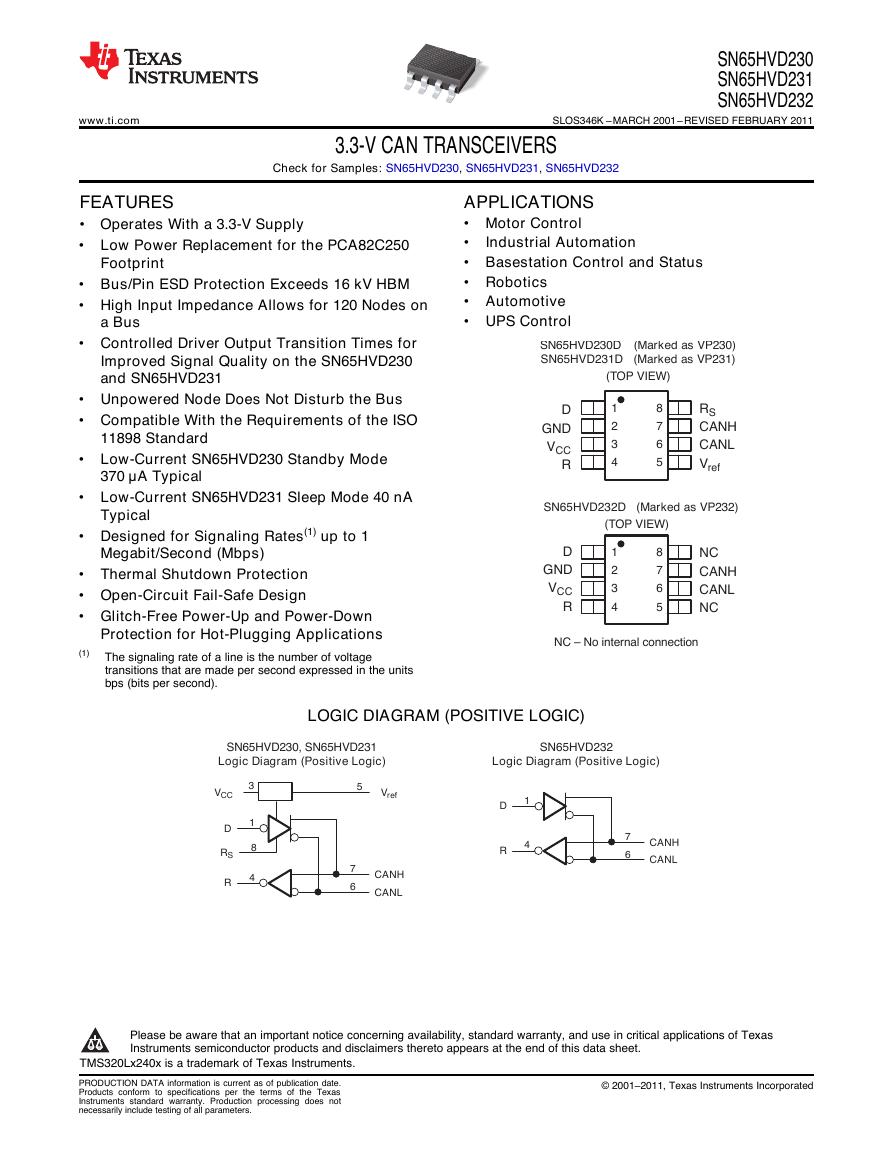
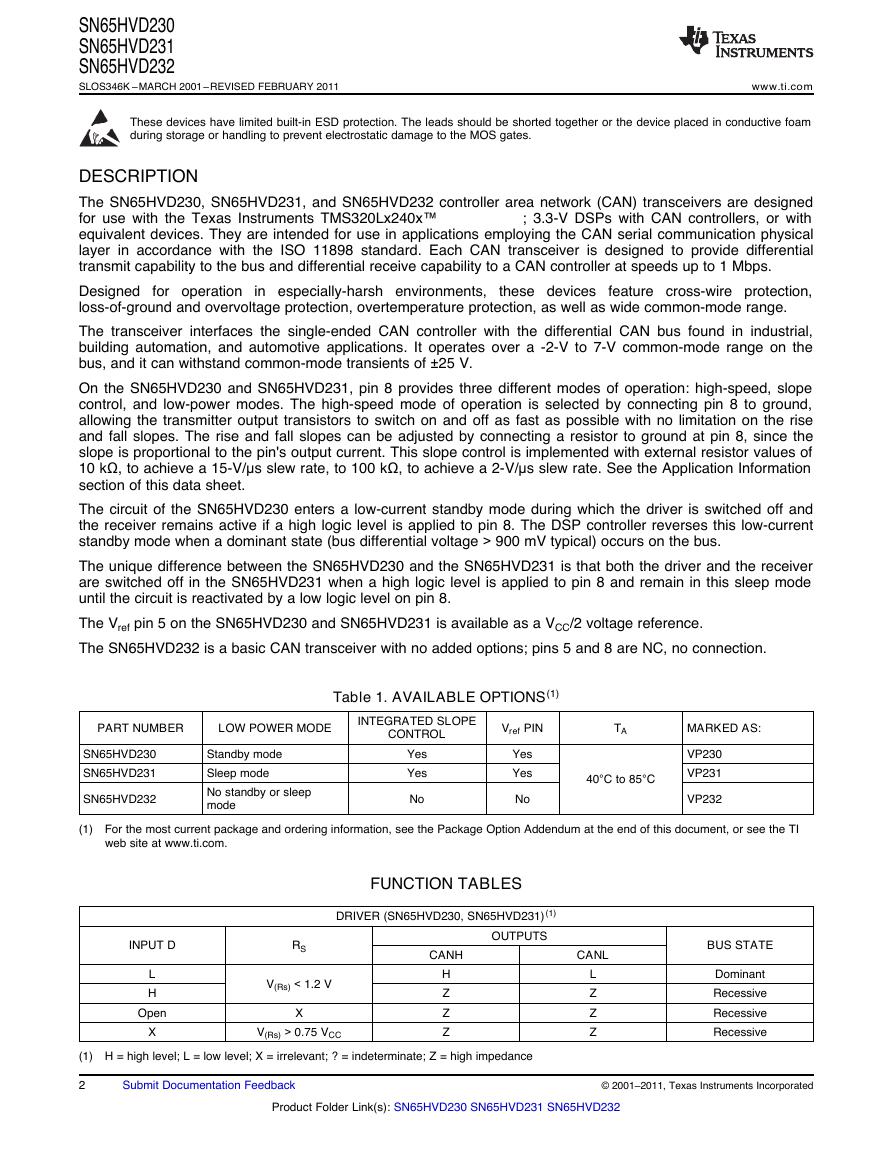


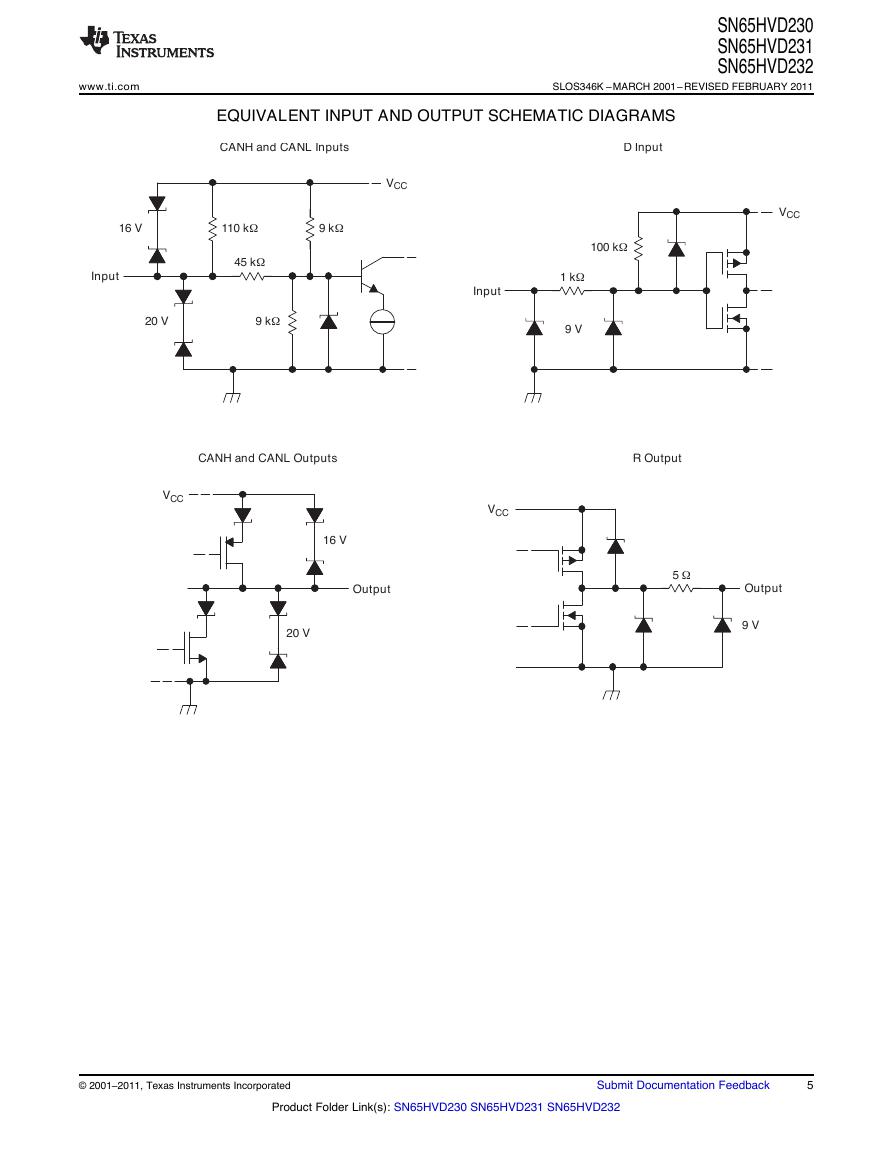
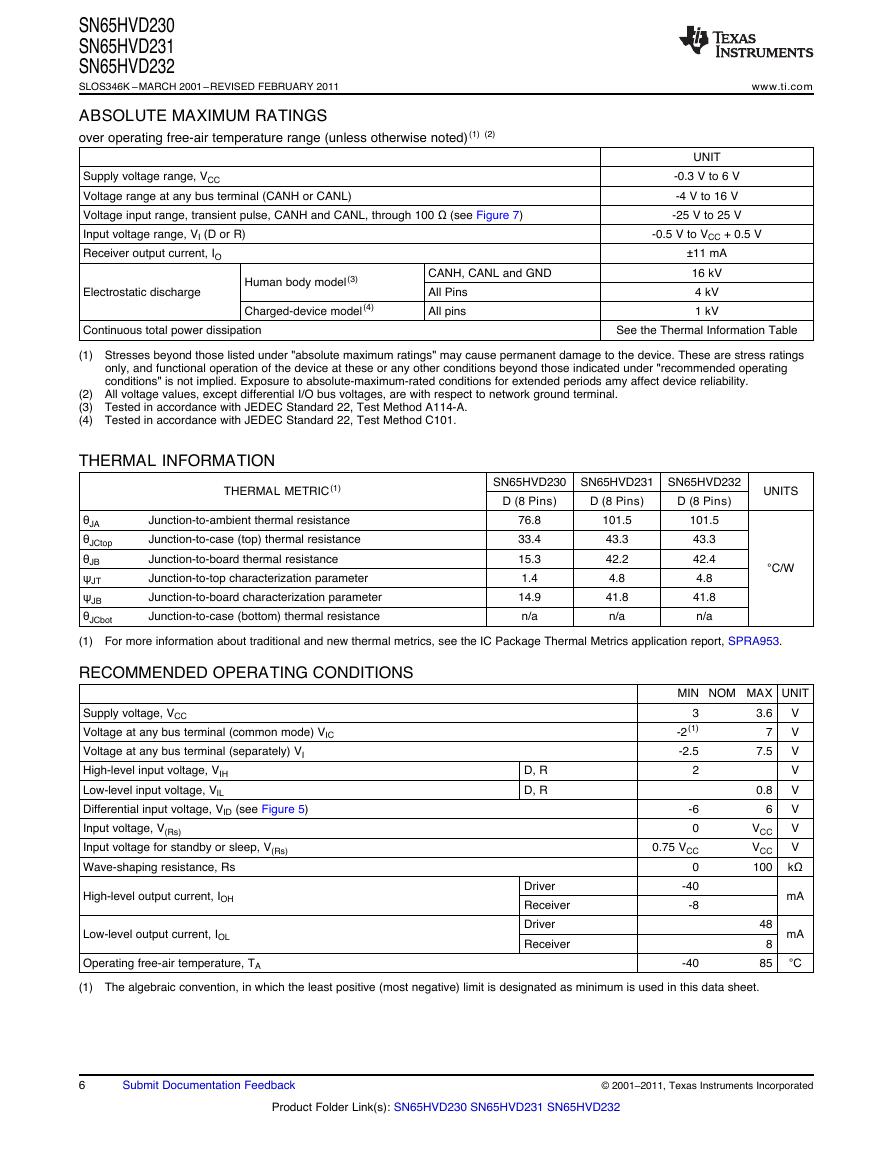
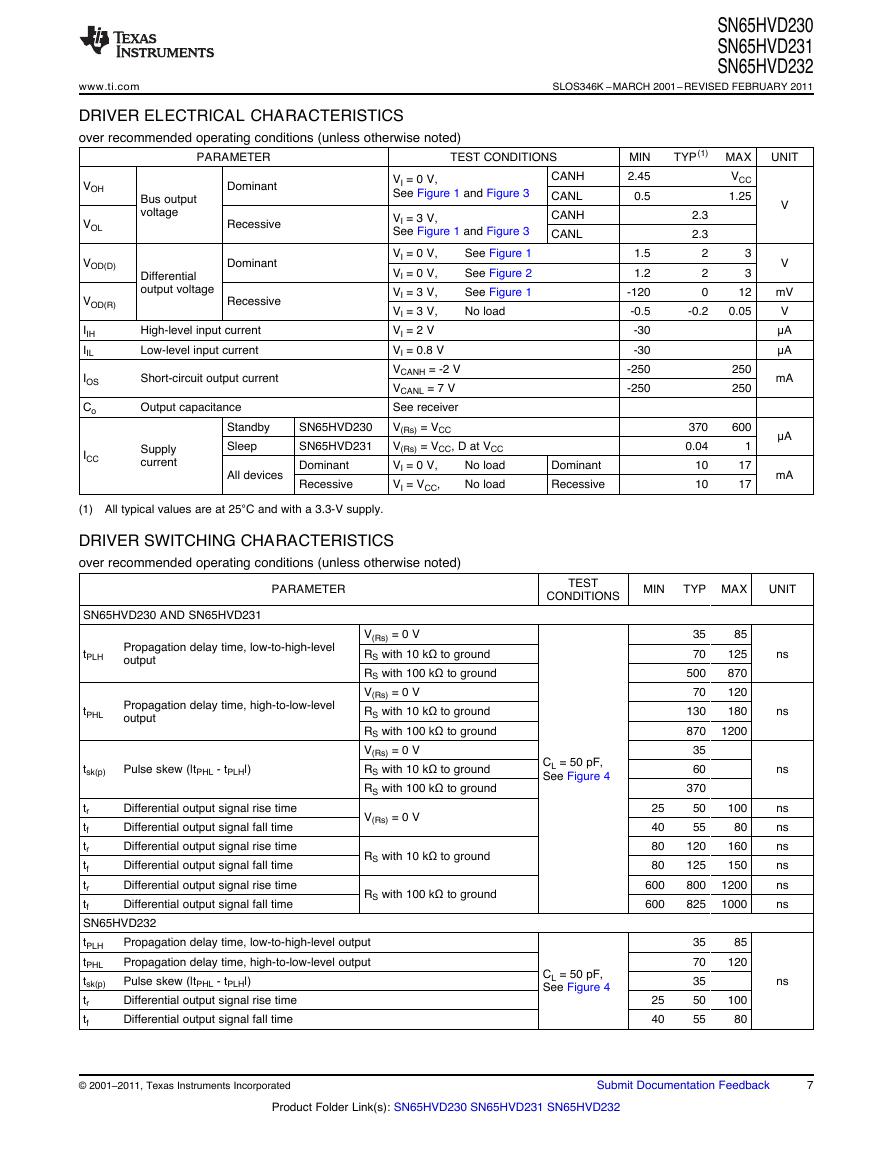









 V2版本原理图(Capacitive-Fingerprint-Reader-Schematic_V2).pdf
V2版本原理图(Capacitive-Fingerprint-Reader-Schematic_V2).pdf 摄像头工作原理.doc
摄像头工作原理.doc VL53L0X简要说明(En.FLVL53L00216).pdf
VL53L0X简要说明(En.FLVL53L00216).pdf 原理图(DVK720-Schematic).pdf
原理图(DVK720-Schematic).pdf 原理图(Pico-Clock-Green-Schdoc).pdf
原理图(Pico-Clock-Green-Schdoc).pdf 原理图(RS485-CAN-HAT-B-schematic).pdf
原理图(RS485-CAN-HAT-B-schematic).pdf File:SIM7500_SIM7600_SIM7800 Series_SSL_Application Note_V2.00.pdf
File:SIM7500_SIM7600_SIM7800 Series_SSL_Application Note_V2.00.pdf ADS1263(Ads1262).pdf
ADS1263(Ads1262).pdf 原理图(Open429Z-D-Schematic).pdf
原理图(Open429Z-D-Schematic).pdf 用户手册(Capacitive_Fingerprint_Reader_User_Manual_CN).pdf
用户手册(Capacitive_Fingerprint_Reader_User_Manual_CN).pdf CY7C68013A(英文版)(CY7C68013A).pdf
CY7C68013A(英文版)(CY7C68013A).pdf TechnicalReference_Dem.pdf
TechnicalReference_Dem.pdf